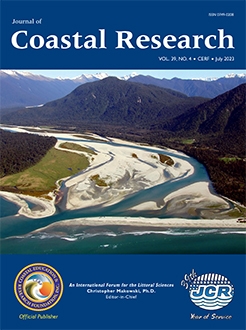Cong, N.V. and Thao, H.V., 2023. Farming practices and environmental quality of integrated mangrove-shrimp farming systems in Tra Vinh province, Vietnam. Journal of Coastal Research, 39(4), 643–652. Charlotte (North Carolina), ISSN 0749-0208.
Integrated mangrove-shrimp farming (IMSF) systems play a pillar role in environmental protection and deliver significant livelihood for communities in coastal areas. Identifying farming practices and environmental quality could improve mangrove forest ecosystem management and conservation. Therefore, practices of 30 households in the IMSF models were investigated. Also, surface water samples in the IMSF models and neighbouring rivers and sediment samples in the IMSF systems in the Long Khanh Mangrove Forest Reserve Area, Long Khanh commune, Duyen Hai district, and Tra Vinh province were collected. The results indicated that average mangrove coverage proportion of interviewed households in IMSF systems was 13% lower than the minimum required by the provincial government (55%). The productivities of shrimp and crab in IMSF systems were 45.86–75.38% and 22.81–60.65% lower than the IMSF systems in the Vietnamese Mekong Delta, respectively. Of all households, 13.33% directly discharged dredged sediment to surrounding rivers. Dissolved oxygen (DO), total suspended solids (TSS), and NH4+ values measured in water-distributed rivers were intolerable to permissible levels per the national standard, posing risks for aquacultural activities and coastal environmental protection as well, while these parameters in the IMSF ponds were in acceptable ranges. These Fe values were 3.50 fold and 1.16 fold higher for the IMSF ponds and adjacent rivers, respectively, than the national standard, but no significant discrepancy was revealed between Fe concentration in ponds and rivers. The present study also showed robustly reliable evidence that the concentration of trace elements, toxicity, persistent organic parameters, oil and grease, and coliform were consistently lower than the allowable degree of the national standard. This study suggests (i) increasing the ratio of mangrove forest coverage, (ii) reorganizing the annual IMSF pond renewal schedule, (iii) intervening techniques reducing total Fe concentration, and (iv) monitoring environmental quality in IMSF systems during and after dredging mangrove-shrimp ponds.





